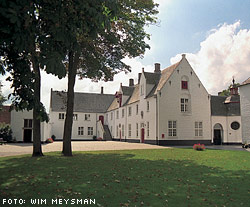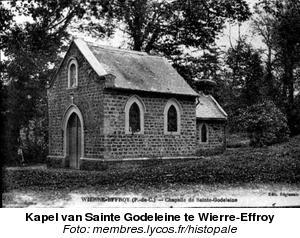
The Abbey Ten Putte (Godelieve Abbey) at Gistel
Author: Mrs. Myriam Van Lerberghe-Thibaut
The Godelieve Abbey is well known in Flanders and in the Flemish region in France.
Godelieve comes from Londesvoorde, nowadays Londefort, a hamlet of Wierre-Effroy, in the Boonen county (Boulogne), Le Boulonnais (present day France).
 The abbey in Gistel is built on the same place where once stood the castle of Bertolf, Lord of Gistel, who let on July 6, 1070 kill
his wife Godelieve, instigated by his mother.
The abbey in Gistel is built on the same place where once stood the castle of Bertolf, Lord of Gistel, who let on July 6, 1070 kill
his wife Godelieve, instigated by his mother.
Numerous miracles are attributed to Godelieve, so Radboud, bishop of Tournai had her canonized 14 years after her death.
The wall enclosed domain, with the white abbey buildings and the luxuriant garden, is now a haven of rest at the border of the Polder environment. The foundation date is not historically established, but it is somewhere between 1137 and 1171. The oldest historical evidence dates from the end of the XIIth century. A few Latin and Middle Dutch biographies are pointing to Edith, Bertolfs daughter from his second marriage, as the founder and the first abbess. She was cured from blindeness by washing her eyes with water from the well where the dead body of the strangled Godelieve was thrown.
During the religious wars the abbey was attacked by Wild Beggars on October 12, 1578. The nuns abandoned the ravaged abbey and settled at Brugge (Bruges) where they established a new abbey in the Boeveriestraat in 1623. The XIVth century tower is the only construction to remain from the buildings at Gistel.
Nevertheless the repaired church (1614-1615) continued to be a lively visited place of pilgrimage.
After 313 years eleven nuns returned from Brugge to Ten Putte on July 2, 1891; to the new abbey buildings, reconstructed as designed by baron Jean-Baptiste de Béthune from Gent (Ghent), the most important local architect of Neo-Gothic art.
Renovating construction was commenced in 1953, guided by architect De Geyter from Brugge. The renewed abbey church was consecrated on June 26, 1962 by M. Rev. Exc. De Smedt.
 The two miracle depicting paintings (XVIIIth century) in the nuns choir visualize the events that illustrate
the legendary attention Godelieve payed to the poor.
Furthermore one can pay a visit to the 'dungeons', the 'miraculous well' and the 'crow chapel'.
The two miracle depicting paintings (XVIIIth century) in the nuns choir visualize the events that illustrate
the legendary attention Godelieve payed to the poor.
Furthermore one can pay a visit to the 'dungeons', the 'miraculous well' and the 'crow chapel'.
Saint Godelieve is still invoked against throat and eye diseases and especially as a guardian and keeper of domestic peace and conjugal fidelity.
Let us speak again about Londefort in Le Boulonnais: it is noteworthy to find at her place of birth a chapel with stained-glass windows, depicting the same scenes as those in Gistel. The difference is that she is called 'Sainte Godeleine' (French spoken) here. The chapel is on a private domain and it is absolutely worth it to be visited.
Also read the comment on the life of Saint Godelieve from the same author.
(We have chosen to use the Flemish version of the name Godelieve,
as the story happened in Flanders, the Dutch
speaking part of present-day Belgium and because the name is very rare in the English speaking world.
The Latin version is Godeliph, in German it is Gottlieb (for men). The name means "loved by God",
so it has the same meaning as Amadeus and Theophilos.
The same remark is true for Gistel that is
commonly written as Ghistel in other languages.
Note from the translator.)
Our commentators: